
February is African American History Month! ![]()
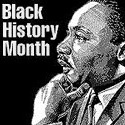
![]()
 African American art
African American art
By Richard J. Powell
Great Depression and World War II Years
As the debates among artists and intellectuals around a “racially representative art” shifted to discussions about social responsibility and a “folk” identity, artists like Aaron Douglas increasingly turned to the public arena as a means of addressing art and life in the 1930s. Douglas’s murals for schools, libraries, and YMCAs exemplified this shift toward the social, as did the colorful, compositionally rhythmic easel paintings of Archibald J. Motley, Jr. Many artists in the 1930s who had begun their careers during the Harlem Renaissance and under the aegis of philanthropic organizations like the Harmon Foundation now made art under the auspices of the Federal Art Project (FAP) of the Works Progress Administration (WPA). These artists, like Allan Rohan Crite, Ernest Crichlow, and Dox Thrash, embraced a visually conservative but politically radical figurative art in which the themes of poverty, racial discrimination, and a growing social consciousness took center stage.
This newfound fascination in the art world with the masses resulted in an expanded appreciation for those artists -- black and white -- who had not attended art school, whose art was often unsophisticated, and who functioned on the margins of the art scene proper. One of these so-called folk artists, the Tennessee stone carver William Edmondson, was honored in 1937 with a one-person exhibition at New York’s Museum of Modern Art. He was the first African American artist to receive that distinction.
In the final years of the Federal Arts Project several painters emerged out of obscurity and into national prominence. The most celebrated in this group was painter Jacob Lawrence. His multipaneled series on such topics as the eighteenth-century Haitian revolutionary Toussaint Louverture, the African American migration experience, and Harlem struck an emotional chord among art aficionados in the 1940s. Paintings by the intuitive artist Horace Pippin on the lives of Abraham Lincoln and John Brown as well as others inspired by biblical verses were also critically acclaimed and highly sought after. Other painters of the late 1930s and early 1940s — like William H. Johnson, Charles Sebree, and Eldzier Cortor — achieved a measure of success in the larger world of art as well, often fusing the style preferences of the day (color abstraction, figural expressionism, and surrealism) with the artists’ affinities for selected African American subjects.
Examples:
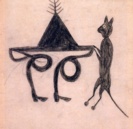
Bill Traylor (American, 1854-1947), Untitled (Anthropomorphic Figure and Cat), 1938-43, pencil on cardboard. See folk art.
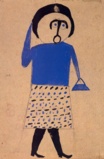
Bill Traylor, Untitled (Woman with Purse), 1938-43, tempera on cardboard.

William Edmondson (American, Nashville, Tennessee, c.1870 - 1951), Crucifixion, c. 1932-1937, limestone, 18 1/8 x 11 x 6 1/8 inches (46.1 x 30.5),
Smithsonian American Art Museum, Washington, DC. See folk art.
![]()

William Edmondson, Angel, c. 1932-38, limestone, Newark Museum, NJ.
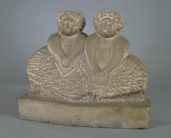
William Edmondson, Mary and Martha, late 1930s?, limestone, 14 x 16 7/8 x 6 7/8 inches (35.4 x 42.7 x 17.3 cm), Hirshhorn Museum and Sculpture Garden, washington, DC.
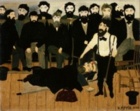
Horace Pippin (American, 1888-1946), The Trial of John Brown, 1942, oil on canvas, 16 1/2 x 20 1/8 inches (41 x 51.2 cm), Fine Arts Museums of San Francisco, CA. This and the following picture are most of a trilogy on the insurrection and execution of abolitionist John Brown. See folk art and history painting.

Horace Pippin, Interior, 1944, oil on canvas, .612 x .766 x .002 m (24 1/8 x 30 1/8 x 3/4 inches), National Gallery of Art, Washington, DC.

Archibald J. Motley (American, 1891-1981), Mending Socks, 1924, oil on canvas, Ackland Art Museum, U of North Carolina at Chapel Hill.
![]()

Archibald J. Motley, Blues, 1929, oil on canvas.
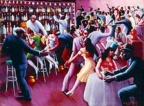
Archibald J. Motley, Nightlife, 1943, oil on canvas, 91.4 x 121.3 cm, Art Institute of Chicago, IL.

Dox Thrash (American, 1892-1965), Railroad Yard, c. 1933-1934, aquatint, etching and pencil on paper, 5 x 3 7/8 inches (12.7 x 9.9 cm), Smithsonian American Art Museum, Washington, DC.

Dox Thrash, East Side, 1939, aquatint on wove paper, 9 7/8 x 7 7/8 inches (25.1 x 20 cm), Pennsylvania Academy of the Fine Arts, Philadelphia, PA.
Selma Burke (American, 1901-1995)
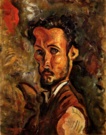
William Henry Johnson (American, 1901-1970), Self-Portrait, 1929, Smithsonian Museum of American Art, Washington, D.C. See self-portrait.
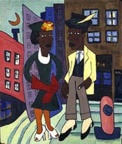
William H. Johnson, Street Life, Harlem,
about 1939-40, oil,
45 3/4 x 38 5/8 inches,
Smithsonian American Art Museum, Washington, D.C.
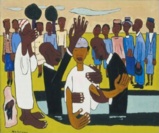
William Henry Johnson, I Baptize Thee, early 1940s, painting, National Museum of American Art, Washington, DC.

William H. Johnson, Chain Gang, Smithsonian Museum of American Art, Washington, D.C.
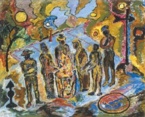
Beauford Delaney (American, 1902-1979), Can Fire in the Park, 1946, Smithsonian American Art Museum, Washington, DC. This painting is one of many New York scenes the artist painted before emigrating to paris in 1953.
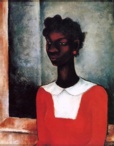
Charles Alston (American, 1907-1977), Girl in a Red Dress, 1934, oil on canvas.

Allan Rohan Crite (American, 1910-), Beneath the Cross of St. Augustine, 1936, oil on canvas,
20 1/8 x 36 inches, Howard University, Washington, DC. See American Scene painting.

Allan Rohan Crite, Sunlight and Shadow, 1941, oil on wood, 64.20 x 99.10 cm, Smithsonian American Art Museum, Washington, DC.
![]()
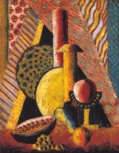
Margaret Burroughs (American, 1917-), Still Life, 1943.
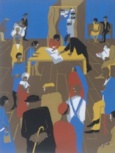
Jacob Lawrence (American, 1917-2000), The Migration of the Negro: The Migrants Cast Their Ballots, 1940-41, silkscreen print, Newark Museum. See American Scene painting.

Jacob Lawrence, Pool Parlor, 1942, gouache on paper, 31 x 22 3/4 inches (78.7 x 57.8 cm), Metropolitan Museum of Art, NY.
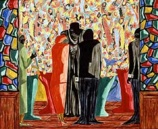
Jacob Lawrence, The Wedding, 1948, tempera on gessoed panel, 50.8 x 61 cm, Art Institute of Chicago.

Jacob Lawrence, The Library, 1960, tempera on fiberboard, 24 x 29 7/8 inches (61.0 x 75.9 cm), Smithsonian American Art Museum, Washington, DC. See genre.
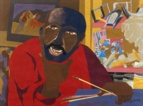
Jacob Lawrence, Self-Portrait, 1977, gouache on paper, 22 1/8 x 30 inches, National Academy of Design, NY. See self-portrait.

Eldzier Cortor (American, 1916-), Man with a Sickle, c. 1945, colored pencil, watercolor, pen and ink on paper.

Charles Sebree (American, 1914-1985), Boy in a Blue Jacket, 1938, oil on canvas.
This is part 5 of ArtPage on African American art
———
The author of this article, Richard J. Powell PhD, is a professor of art and art history at Duke University who specializes in American, African American and African art. His books include Homecoming: The Art and Life of William H. Johnson (1991), Rhapsodies in Black: Art of the Harlem Renaissance (1997), and Black Art: A Cultural History (2002).
Copyright © 2005 Oxford University Press. All rights reserved. Excerpted from Africana: The Encyclopedia of the African and African American Experience, second edition. Edited by Henry Louis Gates Jr. and Kwame Anthony Appiah. Thanks to Yolanda Carden for permission to post this excerpt in ArtPage.
Oxford University Press; April 2005; 5 Volumes; 4,500 pp.; 0-19-517055-5; Special introductory price until April 30th, 2005 of US $425.00. After April 30th, 2005, the price will be US $500.00. Please visit the Oxford University Press for ordering information.
Ninety years after W.E.B. Du Bois first articulated the need for “the equivalent of a black Encyclopedia Britannica,” Kwame Anthony Appiah and Henry Louis Gates Jr., realized his vision by publishing Africana: The Encyclopedia of the African and African American Experience in 1999. This new multi-volume edition of the original work expands on the foundation provided by Africana. More than 4,000 articles cover prominent individuals, events, trends, places, political movements, art forms, business and trade, religion, ethnic groups, organizations and countries on both sides of the Atlantic.
Kwame Anthony Appiah is the Lawrence S. Rockefeller Professor of Philosophy and the University Center for Human Values at Princeton University.
Also see African art, Afrocentrism, bias, discrimination, ethnic, ethnocentrism, multiculturalism, xenophilia, and xenophobia.
https://inform.quest/_art
Copyright © 1996-![]()